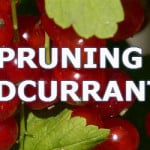Last updated on January 27th, 2022
Our site is reader supported, this means we may earn a small commission from Amazon and other affiliates when you buy through links on our site.
How to prune gooseberries
Gooseberry bushes produce oval fruits that are often red, yellow or green depending on the variety and they taste beautiful either eaten fresh or when used in cooking recipes. Although pruning is not essential, if you do a little winter pruning it will encourage more fruit and help prevent diseases as well as make picking fruit in the summer easier.
When should you prune?
Gooseberries produce fruit on the previous years’ growth so pruning at the wrong time or removing too much growth will result in losing the current or following years’ fruit so correct pruning is essential.
Pruning should be done in winter, November is usually a good time.
How to prune gooseberry bushes
Prune the previous years’ growth back to around 2 buds, this is done because the fruit will form at the base of the previous year’s growth.
Also, prune out any inward shooting stems to keep the centre of the bush open, because this helps the light reach the centre of the bush and this, in turn, will help the fruit ripen, prevent diseases such as mildew, and also makes picking easier. Remove any dead or diseased branches at the same time.
Finally, prune back the leader (main tall stems) by around a third.
Summer pruning
Pruning in summer is not essential, but you can prune back any side shoots to around 5 leaves in June. This just helps light reach the centre of the bush even more and helps fruit ripen.
How to train gooseberries
Gooseberries are good fruit bushes to grow against a wall or up a cane as a cordon. In summer, cut back any side shoots to around 4-5 leaves to help encourage new growth that will produce the following year’s fruit, tie in the main tip as it grows.
In winter prune back the main tip by around a quarter and shorten the side growth you pruned in summer back to around 2-3 buds.
Gooseberry growing tips
- Plant in full sun, in well-drained but moist soil. Some varieties will grow in partial shade.
- Mulch around the base of plants in spring to help retain moisture and suppress weeds.
- Water plants regularly in summer, especially when fruit is forming in summer.
- Traditionally in early June you should remove the first crop by picking around half the crop of the bush, which can be used in cooking and this is known as thinning. Allow the rest of the crop to swell and become soft to the touch. These fruits are full of sugar, sweet and can be eaten fresh and are usually ready a few weeks later.
Controlling pests and diseases
Mildew can be a problem on Gooseberry bushes but some varieties do have some resistance to it. Correct pruning allows the air to circulate around the plant, this can help to prevent mildew but you can also spray with a fungicide if needed. Ensure it can be used on fruit bushes.
Birds and sawflies can also be a problem. Cover plants with netting to protect fruit and buds from birds and check plants for caterpillars in spring and remove by hand if possible, again spray with an insecticide if necessary.
Varieties to try
Invicta – Has some disease resistance and produces white fruit in summer.
Whinhams Industry -This red-fruited variety is good for heavy soils and is ideal for both culinary and dessert.
Leveller – Good disease resistance and produces yellow fruit.
Main image credit: wikimedia.org


